As probably the most popular root vegetable, carrots should not be missing in any garden. Here are helpful tips for planting and growing crunchy carrots.
The cultivation of carrots (Daucus carota subsp. sativus) in the home garden has a very special advantage: the delicious roots can always be harvested fresh over a long period of time. They are a bit smaller at the beginning, but have a particularly mild and sweet taste. Over time, the aroma intensifies and the yield increases.
contents
- Planting carrots: location and requirements
-
Multiply and sow carrots yourself
- Sowing carrots: the right time
- Sowing carrots: the right way to do it
- Growing carrots: suitable varieties
-
Carrot care, watering and fertilizing
- Water the carrots properly
- Fertilize carrots properly
- Caring for carrots: thinning and weeding
- Harvesting Carrots: Recognizing the harvest time
-
Freeze and store carrots
- carrots in the fridge
- Freeze carrots
- Store carrots differently
Planting carrots: location and requirements
The carrot, Daucus carota, likes loose, sandy soil just like all other root and tuber plants. If the soil is too loamy or stony, carrots tend to be leggy (there are two or three instead of one tip), form strange shapes or, in the worst case, are severely stunted in growth. On heavy soils, a preceding green manure with strong root formation (e.g. B.
oil radish) to loosen the soil. In addition, ridge cultures, hill or raised beds can be a good way to cultivate carrots in poor locations.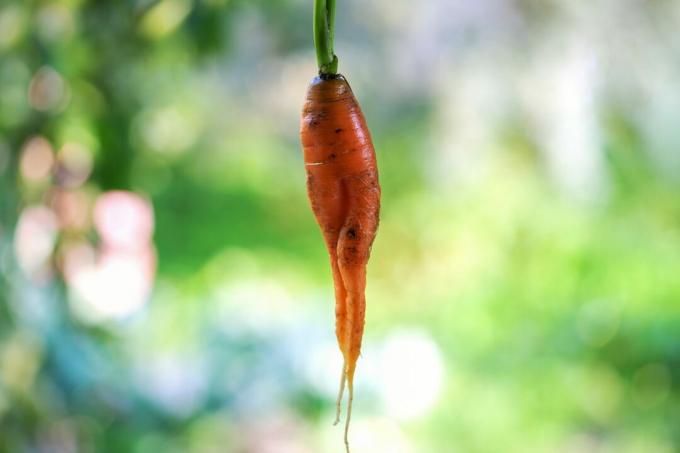
Carrots particularly like sunny locations. Due to the higher risk of attracting the carrot fly, carrots should not be grown on beds that have been freshly manured with manure. Carrots particularly like locations where leeks were previously grown and are happy about onions, dill, garlic or leek in their neighborhood. The smell of the onion plants helps the carrots to keep away the annoying carrot fly.
If you have had problems with the carrot fly, wait at least three years before sowing carrots again on the infested bed. As a precaution, you can choose a different place each year.
Tip: The carrot also finds a sunny spot on your window sill. There you can get the purple carrot 'Purple Haze' and four other colorful vegetables using the Plantura vegetable sets plant. Everything that is required for this is already included in the set.
Multiply and sow carrots yourself
Propagating carrots yourself is quite a complex affair. Carrots are biennial plants and only produce flowers and seeds in their second year. In our latitudes, carrots do not survive the winter, so certain carrots must be harvested in autumn for propagation. The carrots must be harvested unharmed and retain about 2 cm of their green. It is best to store them unwashed in sand in an earth cellar or another cool place over the winter.
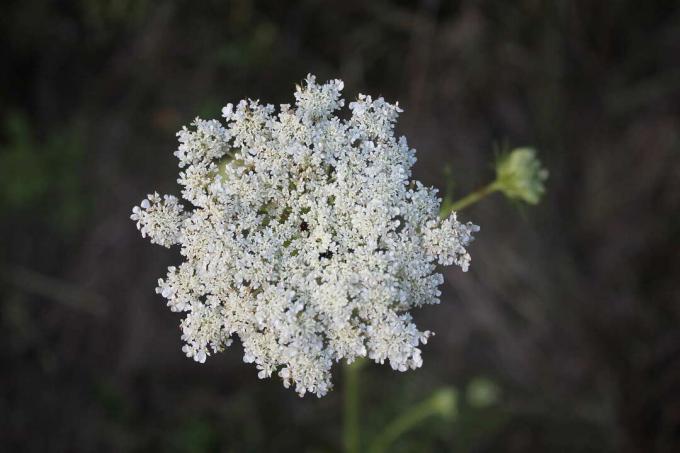
In the spring, for example, plant two of the stored carrots back into your bed. The carrot plants grow to a height of more than a meter and form beautiful umbels of flowers around July. At the end of September the seeds are ripe. To prevent self-seeding, cut off the seed umbels in good time and then hang them up to dry. The seeds are detached by gently rubbing the umbels between your fingers.
Sowing carrots: the right time
Carrots are not particularly sensitive to cold and can therefore be sown early in the spring. Early sowing, for example, at the beginning of March is more advisable for early varieties that can be harvested from around the end of May/beginning of June, depending on how warm the spring is. In order to be able to harvest continuously freshly, sow every four weeks from the beginning of March until May, for example. So-called storage carrots, which you want to keep for the winter, should also not be sown until May. They will then be just big enough until autumn and can then be stored.

Sowing carrots: the right way to do it
- Make several grooves about 3 cm deep, spaced 20 cm apart
- Sow the carrots thinly, preferably with a distance of 2 to 4 cm between each seed
Tip: Carrots have a very long germination time. It can take up to four weeks before you see the cotyledons on the soil surface. When you enter your preferred grooves between each carrot radish sow, make optimal use of the space between the carrots. Depending on the weather, the radishes are ready to harvest after about six weeks and the carrots have their full space available again.
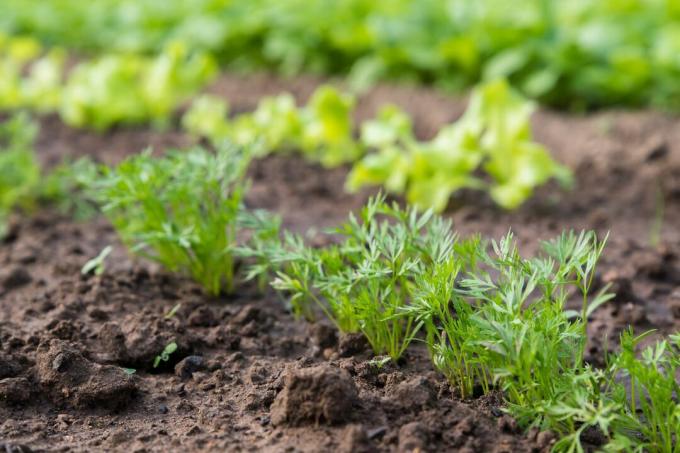
- Sow a row of dill or radishes around the carrots. These germinate faster and thus mark the location of the carrots. Incidentally, dill and carrots promote each other's growth.
- Cover the grooves and seeds with soil, press down lightly and water.
Another way to sow is to lay seed tapes. With them, the carrot seeds are already the right distance apart and you certainly don't have to thin them out later.
Growing carrots: suitable varieties
The different types of carrots differ mainly in the time of ripening, suitability for the location, taste and shape. There are strongly conically shaped carrots, which are also often referred to as "Chantenay type", rather round, cylindrical to blunt or very long varieties. The suitability for storage can also vary, the early varieties are usually less suitable for storage. A wide range of carrot varieties you'll find here.
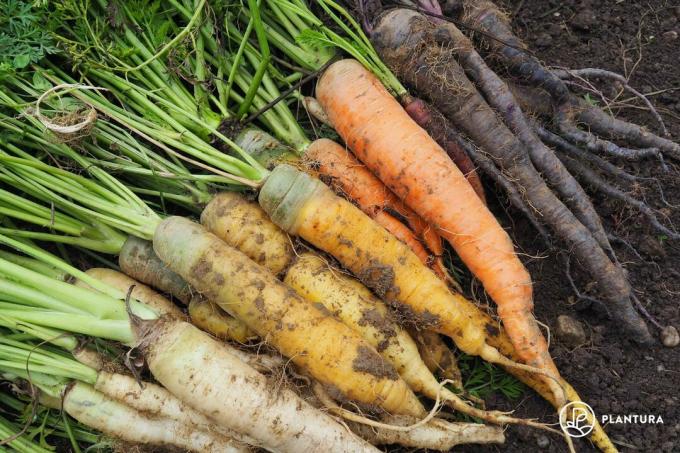
Carrot care, watering and fertilizing
Carrots are generally a very low-maintenance vegetable crop. They only have to be watered when it is dry, with good bed management they do not have to be fertilized and with the correct seed spacing or the use of seed tapes they also do not have to be thinned out. If the soil in your bed is a bit settled or the carrots have been sown a little too high, the heads of the roots may be sticking out of the ground. By restoring soil to the roots, you will prevent green carrot heads from forming.
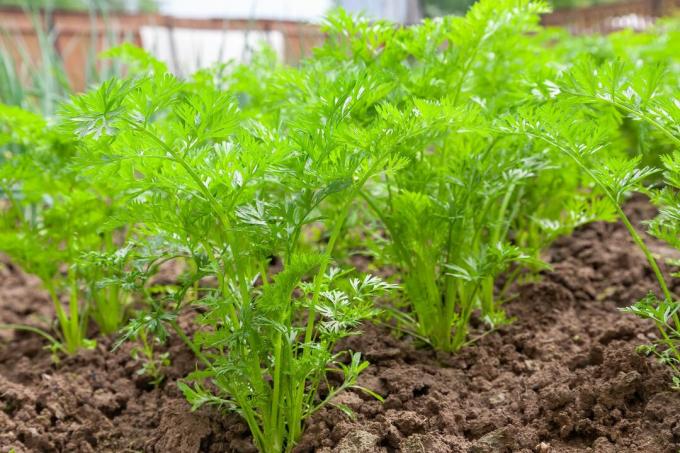
Water the carrots properly
Carrots like it evenly moist, but reduce their moisture requirements as root size increases. The bigger the carrots get, the more they tolerate a bit of drought. Anyway, carrots should only be watered when it is dry. Because an excess of water means that the plants put their energy into strong leaf instead of root growth.
Fertilize carrots properly
Carrots are among the medium eaters. So they don't need a lot of nitrogen and react with heavy fertilization with strong leaf growth. But since you don't want to harvest the leaves, but the roots, you should be careful with fertilizing. Compost, in autumn together with a soil-penetrating green manure such as fodder radish, provide enough nutrients for a subsequent, rich carrot harvest. Equally suitable is a primarily organic organic fertilizer that slowly and gently transfers its nutrients to the carrot. Our Plantura Organic Tomato Fertilizer fulfills these conditions excellently and also stimulates an active and healthy soil life.
If the bed was cleared early last year, a nitrogen-fixing green manure plant such as clover or lupine can also be planted. Manure should never be fertilized in spring, but small amounts of compost can help for seeding or youth development if the bed is very poor in nutrients.
Caring for carrots: thinning and weeding
Carrots that have been sown too tightly must be thinned out. If this does not happen, you will harvest a lot of mini carrots, even after waiting so long, but no large specimens. The plants then simply have too little space to form larger roots. At the beginning of development, it is difficult to tell how many plants are involved and how many should be pulled out, especially in the case of very tightly sown plants. Therefore, one should wait with the thinning until the plants have grown at least 5 cm high. Thinning should take place in wet rainy weather. The rain prevents the odor emanating from the small roots from being widespread and attracting the carrot fly to your garden.

The pulled out carrots will grow very poorly if you try to plant them in another place. If the plantlets are still very small, save yourself the work and put the plantlets on the compost. If there are already tiny carrots, enjoy the sweet delicacies. Close the resulting cavities next to the remaining carrots with soil and press the soil firmly. After thinning, each plant should have at least an inch of space between the next plant. For fall varieties that are intended to be harvested very thickly, thinning out thinner carrots about a month before the final harvest can be useful.
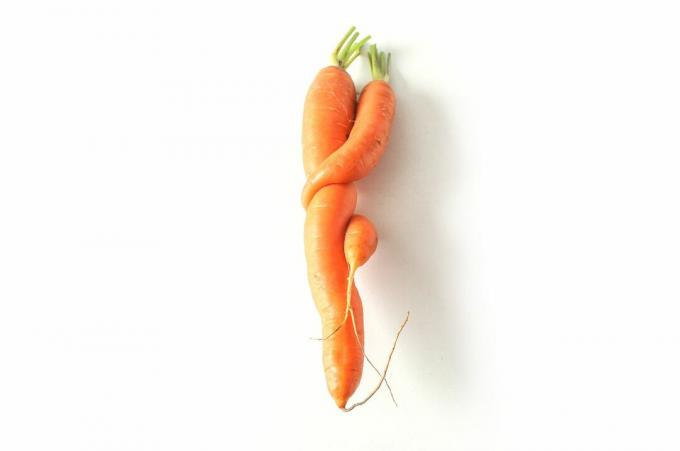
Carrots are not particularly strong and competitive and should therefore be weeded when young. When weeding with a hoe you have to be very careful because the small roots are easily injured. It is safer to remove the weeds by hand.
Harvesting Carrots: Recognizing the harvest time
There is no optimal time to harvest carrots. When to harvest is literally a matter of taste. Because the bigger the roots get, the more intense their taste. Harvested earlier, carrots are sweeter and milder, and almost everyone will want to eat them unpeeled. If you like the delicious roots in all sizes, you can simply harvest as needed.

In general, it is said that carrots can be harvested after about three months. Of course, this time varies depending on the prevailing weather conditions. Carrots sown in a cold March are likely to take a few more days to weeks to germinate than carrots sown in April or May. Accordingly, carrots sown very early will tend to be even smaller and thinner when harvested after three months and should perhaps remain in the ground a little longer.
As the carrot harvest works correctly, you can find out here.
Freeze and store carrots
Since carrots are excellent for harvesting when needed, there is often no need for long storage in many home gardens.

carrots in the fridge
Carrots lose moisture quickly and should therefore be stored in the refrigerator. Wrapped in newspaper or in a cling bag with some air holes to prevent mold, the carrots will keep for a good week. Then they slowly begin to shrink.
Freeze carrots
Carrots can be prepared ready to cook, i.e. peeled and chopped if necessary, and also frozen. However, they change their consistency a bit. However, this form of preservation is ideal for stews, for cooking in various dishes or for a soup that is pureed afterwards anyway.

Store carrots differently
However, carrots can also be stored in sandboxes in dark and cold cellar rooms, traditionally in so-called earth cellars.
Everything to Origin of the carrot, and how it is also called, you can read in our special article.

